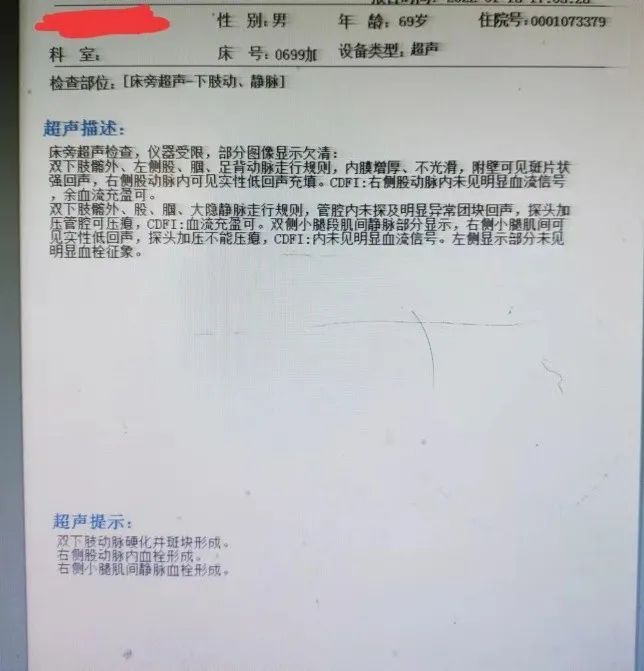Case sharing:
The patient, male, 69 years old, was unconscious and unresponsive in a room with a coal stove more than 1 hour ago. When he arrived at our department, the patient’s consciousness improved. High suspicion of carbon monoxide poisoning, so the patient was given an emergency blood gas analysis and showed: FCOHb 30.2%, confirmed carbon monoxide poisoning. After being admitted to the hospital, no abnormality was found in the physical examination, and high-flow oxygen inhalation and hyperbaric oxygen therapy were given. Two days later, when the shift was handed over, it was found that the patient’s right lower extremity was slightly swollen, the dorsal pedis artery pulse was not palpable, and the left lower extremity dorsal pedis artery pulse was good.
What’s going on?
Inquire the patient, complaining that he fell to the ground before admission, lying on the right side, and now feels pain in the medial side of his right foot, and has a history of coronary heart disease and hypertension. , usually taking aspirin tablets and amlodipine tablets for drug control,
given an emergency ECG as shown below: showing atrial fibrillation.
Immediately notify the doctor and perform ultrasound examination of both lower extremities. The results are as shown in the figure: Prompt: thrombosis in the right femoral artery;
thrombosis in the right intermuscular vein of the calf
p>

A subcutaneous injection of dalteparin injection 5000u was given, and the patient was transferred to the Department of Cardiology for further treatment.
Case summary:
1
Hypoxemia caused by carbon monoxide can cause myocardial damage at the cellular and subcellular levels. Mb binding reduces the oxygen supply to the mitochondria; at the same time, CO directly damages the mitochondria of cardiomyocytes by damaging the mitochondrial respiratory chain at the level of cytochrome c oxidase, which in turn causes oxidative phosphorylation disorders and reduced myocardial energy supply, resulting in decreased myocardial contractility. In addition, ischemia-reperfusion injury, free radical generation, and elevated catecholamine levels are all mechanisms of CO poisoning-induced myocardial injury. In adult patients, myocardial damage caused by CO poisoning can manifest as myocarditis, angina pectoris, myocardial infarction, arrhythmia, and in more severe cases, heart failure and even sudden death. atrial fibrillation The atrium loses its effective contraction and becomes irregular fibrillation, causing the blood to form turbulent flow and vortex in the atrium, making the blood easy to coagulate into a thrombus and attach to the inner wall of the atrium. The emboli of this kind of thrombus are extremely unstable and fall off easily. Once they fall off, they flow to the whole body with the blood circulation, causing blockage of the corresponding organs.
3
Three conditions for thrombosis:
1) Cardiovascular endothelial cell damage: it is the most important and common cause of thrombosis, Carbon monoxide poisoning can cause extensive endothelial damage throughout the body, activate the coagulation process, cause DIC, and form thrombi in the systemic microcirculation.
2) Abnormal blood flow: mainly refers to the slowing of blood flow and obstruction of blood flow.
3) Increased blood coagulation.
4
The patient had a history of coronary heart disease and hypertension in the past, and this time he was admitted to the hospital for treatment due to carbon monoxide poisoning, which may cause arrhythmia and cardiovascular endothelial cell damage; When the patient was found, the patient had fallen and was lying on the right side, and the blood circulation of the right limb was blocked, so that the dorsal pedis artery was not palpated, the limbs were swollen, and the occurrence of deep vein thrombosis in the lower limbs.
Experience sharing:
1
For patients with carbon monoxide poisoning, especially those with a history of falls, we should pay attention to the skin of the patients in time Condition and peripheral blood supply, pay attention to whether the patient has been under pressure on the limbs for a long time.
2
Physicians pay more attention to the damage of carbon monoxide to the nervous system, and pay less attention to the damage of the heart and the presence or absence of thrombus. For such patients, electrocardiogram examination and examination should be given in time. Examination of cardiac enzymes, D-dimer, and ultrasound of the lower extremities.
3
Patients with carbon monoxide poisoning complicated by atrial fibrillation should be informed of venous thrombosis prevention measures in time.
(Li Fangfang, Liaocheng Second People’s Hospital)
References:
[1] Sun Liqun, You Hailong, Guo Gongliang. Sodium creatine phosphate in children with acute Application effect in cardiac damage caused by carbon monoxide poisoning [ J]. Chinese Journal of Laboratory Medicine, 2018, 04: 57
[2] Zhao Hongjing. Clinical analysis of myocardial damage caused by acute carbon monoxide poisoning [J]. Jiangxi Medicine, 2017, 02: 138.
[3] Guo Yutao. Status and changes of clinical epidemiology and antithrombotic management of atrial fibrillation in the elderly in China[j]. Chinese Journal of Geriatric Cardiovascular Diseases, 2017, 9(19): 988-990.